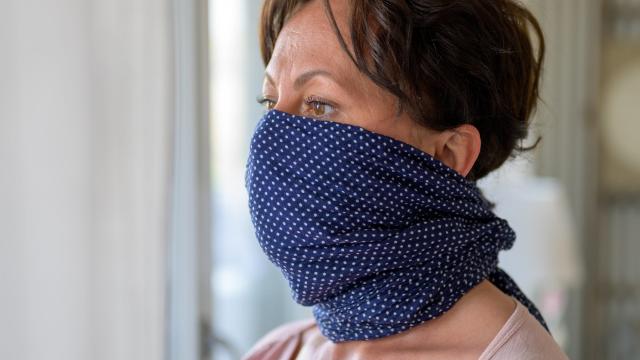There’s a new study claiming that neck gaiters like Buffs are worse than not wearing a mask at all. I’m not convinced that this study should be taken at face value, but it’s also reasonable to be suspicious of Buffs, bandanas, and other face coverings that aren’t designed to do the job of a mask.
(To be totally clear: Buff is a company that makes thin, spandex-y neck gaiters that have become eponymously known to many as “buffs.” They also make a purpose-built face mask. That mask was not tested in the study we’re talking about here.)
We’ve long known that N95 respirators do the best job of protecting both the wearer and others. Surgical “procedure” masks — those disposable medical masks — are the next best thing, keeping most (but not all) of your respiratory droplets to yourself while possibly providing protection from others.
Since those masks aren’t always available, cloth masks are what most of us have ended up wearing. Cloth masks provide protection in a similar way to disposable procedure masks, although they may not be as effective.
That said, not all masks are equal. As we all scrambled to find cloth masks, companies started advertising different types. Anyone who sells gaiters was advertising their gaiters; companies that made masks with valves were selling masks with valves. Of course, that doesn’t mean these are the best choices.
What this study found
So far, there is not a great way to test masks to see if they are “good enough” to protect against the coronavirus. Medical masks go through certain quality-control checks, but fashion masks have no such protocol. Nor do the ones you sew or improvise at home.
So a group of researchers from North Carolina published a paper describing an inexpensive tool that could be used to test masks. The device is basically a box with a laser and a cell phone camera; you stick your masked face up to the box and speak into it. Light from the laser bounces off the droplets that spray out of your mouth (or that don’t, depending on how well the mask works), and it’s recorded by the camera.
The device doesn’t test whether people got sick or whether an infectious dose of virus was delivered; it just looks for droplets in the air. No coronavirus was involved in this test.
So, to test the device, researchers spoke into the box while wearing a variety of masks. As expected, people produced very few droplets when wearing N95s, with surgical masks performing better and cloth masks varying according to their materials and construction.
Here’s the big caveat, though: this was a proof-of-concept to see if the box could measure droplets, and if the droplets looked different from mask to mask. It is not a definitive test of the masks themselves. In fact, the researchers wrote in their conclusion:
Again, we want to note that the mask tests performed here (one speaker for all masks and four speakers for selected masks) should serve only as a demonstration. Inter-subject variations are to be expected, for example due to difference in physiology, mask fit, head position, speech pattern, and such.
What should we know about different types of masks?
First, that if something isn’t really a mask, we shouldn’t expect it to perform like one. Both the CDC and WHO recommend that a mask fit snugly around your mouth and nose, which rules out buffs, as well as bandanas tied bank-robber-style. They also warn against wearing a mask with an exhalation valve, since that just spews your germy air out into the world.
None of this is new. What is new in this study is the suggestion that a buff may be worse than nothing, because its open weave seems to split bigger droplets into smaller ones. That could be a problem. See all those weasel words? That’s the best way I can accurately describe the results. It’s very possible buffs could turn out to be worse than nothing, but the question needs more study. Nobody has studied whether buffs actually increase the chances that someone might get sick.
I think it’s worth reconsidering your buff, if you wear one. I know a lot of runners like to have one around their neck so they can pull it up if they pass someone. We now have some data to suggest that may not be a great idea, but we already knew that a buff is not really a mask — so maybe we shouldn’t have been relying on them in the first place.

Leave a Reply
You must be logged in to post a comment.